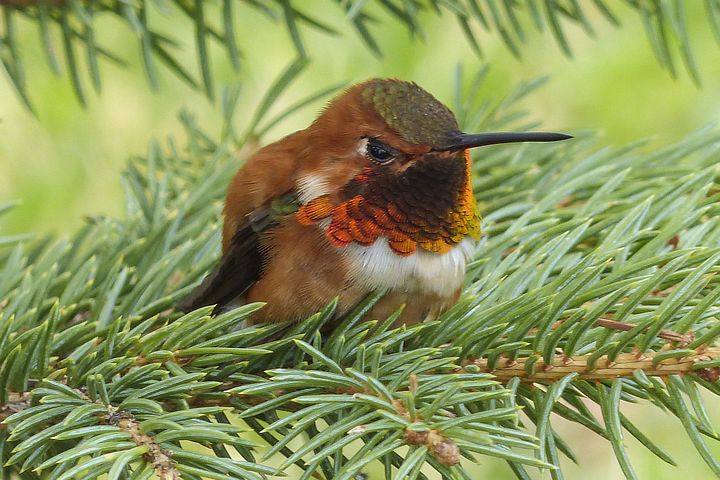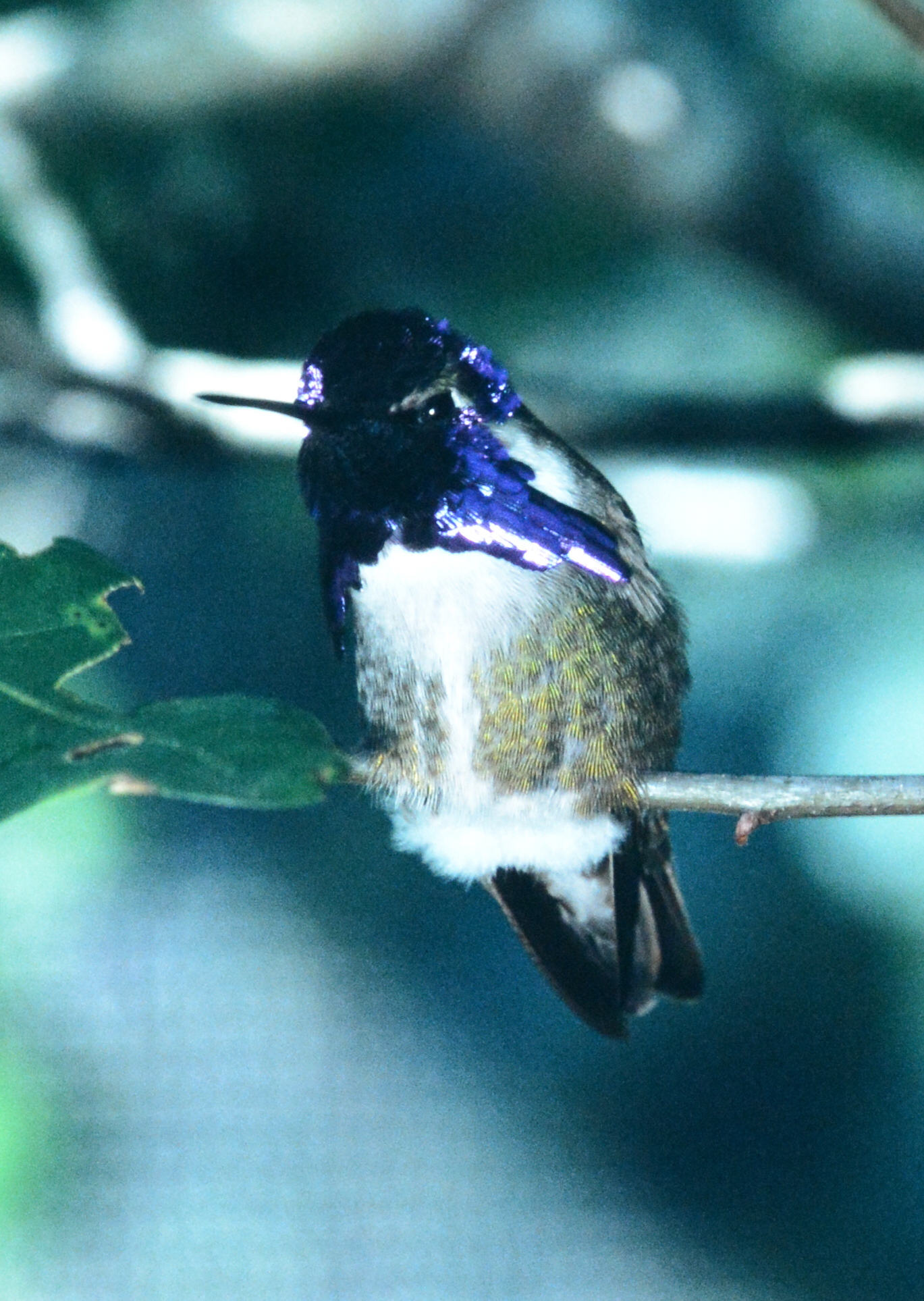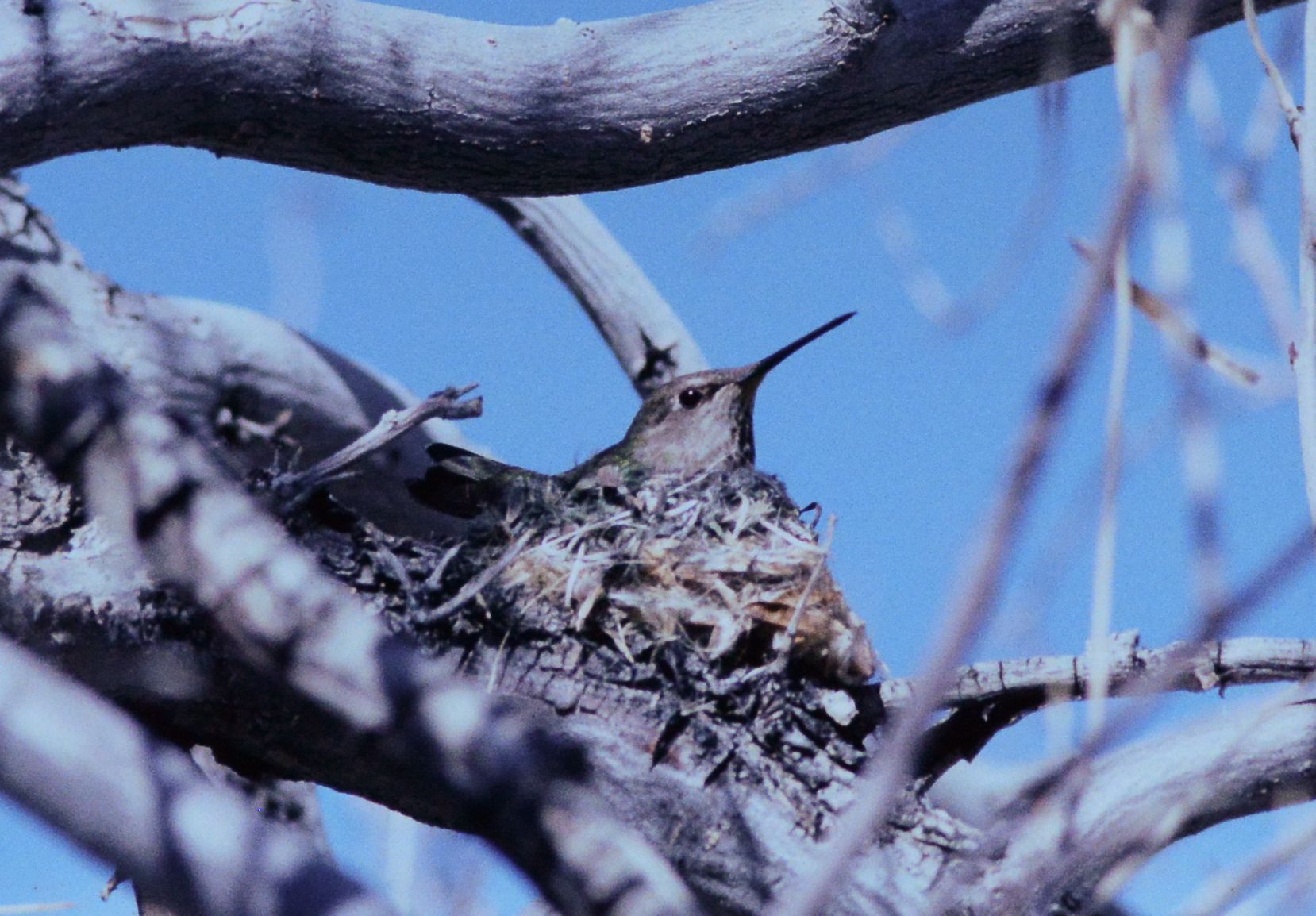The smallest bird you’ll observe zipping around or hovering within gardens and parks in the Sonoran Desert is the hummingbird. Southeastern Arizona hosts more than a dozen species of hummers as year round residents, seasonal visitors or accidental tourists during migration. Their wing speed of 80 beats or more per second is remarkable which, along with their flapping tail feathers, accounts for the buzzing noise you may hear as they flit between nectar supplies. Nests are crafted of lichens intertwined with spider webs and well camouflaged. Broods are usually 2 eggs, occasionally 3.
Don’t be fooled by the size of these tiny, fairy like birds sporting iridescent colors and pointed bills. At feeders and darting among tube shaped flowers they are territorial and warrior-like, defending food sources, nests and potential mates with their dagger like beaks. Scrappy and relentless, they are capable of flying up, down, backward and sideways. Many species are also proficient at flying thousands of miles along migration routes between Alaska and Mexico or Central America.
Hummingbirds You’ll See in the Greater Phoenix Area
There are 7 hummingbird species commonly viewed in the greater Phoenix area:
- Allen’s
- Anna’s
- Black-chinned
- Broad-tailed
- Calliope
- Costa’s
- Rufous
I will tempt you with interesting and fun trivia about each of these plus suggest local habitats where you are likely to find the species. For more detailed descriptions, photos of both male and females and additional fascinating facts, consult a bird guide or websites that feature hummingbirds and their characteristics.

Allen’s Hummingbird
Allen’s Hummingbird breeds along the Pacific coast and is typically viewed in our area only when migrating between western California and Mexico in the spring and fall. They are small, chunky birds measuring about 3.5 inches or 9 cm long and sport shades of copper, orange and green. Males have a distinct red-orange throat and emit a bee-like buzz with their wings. In addition to drinking flower nectar, these hummers flycatch or pluck insects from plants with their straight bills.

*Anna’s Hummingbird
Once common to the Phoenix area in winter only, Anna’s Hummingbird has increased both visiting and breeding numbers in Arizona in early spring and late fall, making it one of the hummingbird species you are most likely to see in the Phoenix area. Partial to desert scrub and riparian woodlands, this hummer is also a frequent guest in residential gardens and especially those with exotic plants. Whereas many hummingbirds are vocally silent, these males are unique in their ability to make sounds that are musical in nature. Highly territorial, the males also do elaborate aerial dives ending in tail-produced popping sounds to deter intruders such as other birds and people. Anna’s Hummingbird is one of the larger hummers in the Phoenix area yet is considered a medium-sized, slightly stocky hummer. Grey-green in color, males are distinguished by an iridescent red-pink head and throat.

*Female Black-chinned Hummingbird

*Male Black-chinned Hummingbird
The Black-chinned Hummingbird is a summer native to Arizona, arriving in March or April and departing in October to spend winter in Mexico. They are highly adaptable and common in middle and lower elevations choosing habitats of deciduous woodlands, canyons, meadows, orchards or cities with flowering trees and shrubs. Similar to the Allen’s Hummingbird in length, they are more slender with an almost straight black bill. Males have a dark throat edged in purple; female throats are pale. Both males and females have muted green back feathers and dull grey chests. They are often spotted on high tree snags when they aren’t zipping erratically between nectar sources. They are frequent visitors to feeding stations throughout the greater Phoenix area. Males use aerial display flights which include 70-100 feet pendular dives to attract females or defend their territories.

Broad-tailed Hummingbird
Another native to Arizona is the Broad-tailed Hummingbird which typically arrives in late spring and returns to Mexico at the end of September. Breeding habitats include higher elevations on the fringe of pinyon-juniper, oak, pine and evergreen forests. Males make audible metallic chirps with their wings as they dart between blossoms and perform rapid aerial dives. Adorned with noticeable iridescent green on dorsal parts and white chests, their tails flash white tips when in flight. Females and young hummers have green spots on their throats; males sport a magenta-red throat patch. Considered to be a medium size hummer, they have slender bodies and big heads (relative to other hummingbird species).

Calliope Hummingbird
The smallest of the hummingbirds in our area and in the United States is the Calliope Hummingbird with its relatively short tails, wings and bills. Displaying metallic green on their heads and upper parts, both males and females have white or buff breasts. Males are easy to distinguish because they have long streaks of purple-magenta feathers down their necks and perform impressive 100 foot, U shaped aerial dives during courtship. These birds may be tiny but are fierce during the breeding season and have been observed pursuing much larger birds in defense of their nests and mates. They spend winters in Mexico but travel through Arizona in the spring enroute to their breeding grounds along the Pacific coast. Similar to the Allen Hummingbird, the Calliope sips nectar from plants and is a flycatcher of insects.

*Male Costa’s Hummingbird

*Female Costa’s Hummingbird
The Costa’s Hummingbird chooses desert and sage scrub or chaparral as a preferred habitat and drinks nectar from different desert plants such as ocotillo and chuparosa. Their breeding season falls mainly between late winter and spring and to avoid Arizona’s hot summers they then migrate to the coast of California. The female is the nest builder and chooses shrubs, small trees and occasionally a cactus or yucca for the nest site. These are small, compact hummers with a short tail and stooped presentation when perched. Males feature a remarkable purple-amethyst gorget atop their heads and along their necks that conveys a mustached appearance. Both males and females have green backs and white underparts. Known to be more reticent than other hummers, they are likely to visit your feeding stations if you have more than one nectar source available.

Rufous Hummingbird
Last but never least is the bold and territorial Rufous Hummingbird, a common visitor to Arizona hummingbird feeders during their long migrations between Alaska and Mexico. In areas where there are nectar rich flowers and feeders they may stay for a week or two to rest and bulk up for their arduous travels. Unfortunately, Rufous Hummingbirds may discourage other hummers from visiting your feeders as they are naturally greedy and will chase competitors away. Males are orange-brown in color; females are green-orange. They choose desert scrubs, mountain meadows and other locations with flowers and feeders for their migratory habitats.
Feeding Hummingbirds
Hummingbirds require a significant amount of nectar to maintain their high metabolic rates. You can attract resident and transient hummers to sip in your presence by hanging specialized feeders filled with nectar and planting native tubular flowers in yards and parks. Red seems to be a favorite flower color although my hummers also frequent pink, yellow and purple blossoms. Native Arizona plants such as trumpet creeper, lupine, salvias, penstemon, Columbine and bee balms are a source of rich and natural food for hummers. Hummers also consume and feed insects to their young so avoid using insecticides in your yard. Nearby branches or perches for resting between drinks add an inviting touch.
Safe and appealing nectar is easily made by stirring 1 cup of white (not raw) sugar into 4 cups of water and boiling for a minute or two. Please do not add food coloring or dyes which are harmful to hummingbirds and not necessary. Leftover nectar should be stored in your refrigerator. Change the nectar before it gets cloudy and toxic to hummers. Feeders will get moldy relative to the humidity and ambient temps and should be cleaned with mild soapy water, rinsed thoroughly and refilled as needed.

*Uncommon to the Phoenix area is the Ruby-throated Hummingbird
Places to See Hummingbirds in the Phoenix Area
- Desert Botanical Gardens in Phoenix
- Gilbert Riparian Preserve at Water Ranch in Gilbert
- Hummingbird Habitat at Desert Breeze Park in Chandler
- Rio Salada Audubon Center in Phoenix
See Hummingbirds at Arizona Vacation Home Rentals’ Properties




Save money, book with us.
Phone/Text: 480.470.7739
Reservation Hours: 8:00 a.m. to 6:00 p.m. MST
*Photo credits: © Gilbert S Grant





